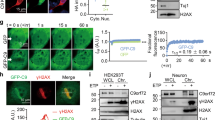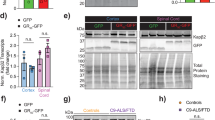Abstract
Expanded hexanucleotide GGGGCC repeat in a noncoding region of C9ORF72 is the most common cause of frontotemporal dementia (FTD) and amyotrophic lateral sclerosis (ALS). However, its molecular pathogenesis remains unclear. In our previous study, the expanded GGGGCC repeats have been shown to be sufficient to cause neurodegeneration. In order to investigate the further role of expanded GGGGCC repeats in the neuron, the normal r(GGGGCC)3 and mutant-type expanded r(GGGGCC)30 expression vectors were transfected into Neuro-2a cells. Cell proliferation, dendrite development, and the proteins’ levels of microtubule-associated protein-2 (MAP2) and cyclin-dependent kinase-5 (CDK5) were used to evaluate the cell toxicity of GGGGCC repeats on Neuro-2a cells. The results were shown that expression of expanded GGGGCC repeats caused neuronal cell toxicity in Neuro-2a cells, enhanced the expression of pMAP2 and pCDK5. Moreover, overexpression of Purα repaired expanded GGGGCC repeat-inducing neuronal toxicity in Neuro-2a cells and reduced the expression of pMAP2 and pCDK5. In all, our findings suggested that the expanded GGGGCC repeats might cause neurodegeneration through destroyed neuron cells. And the GGGGCC repeat-induced neuronal cell toxicity was inhibited by upregulation of Purα. We inferred that Purα inhibits expanded GGGGCC repeat-inducing neurodegeneration, which might reveal a novel mechanism of neurodegenerative diseases ALS and FTD.







Similar content being viewed by others
References
Almeida S, Zhang Z, Coppola G, Mao W, Futai K, Karydas A, Geschwind MD, Tartaglia MC, Gao F, Gianni D, Sena-Esteves M, Geschwind DH, Miller BL, Farese RV Jr, Gao FB (2012) Induced pluripotent stem cell models of progranulin-deficient frontotemporal dementia uncover specific reversible neuronal defects. Cell Rep 2:789–798
Anne SL, Saudou F, Humbert S (2007) Phosphorylation of huntingtin by cyclin-dependent kinase 5 is induced by DNA damage and regulates wild-type and mutant huntingtin toxicity in neurons. J Neurosci Off J Soc Neurosci 27:7318–7328
Blichenberg A, Schwanke B, Rehbein M, Garner CC, Richter D, Kindler S (1999) Identification of a cis-acting dendritic targeting element in MAP2 mRNAs. J Neurosci Off J Soc Neurosci 19:8818–8829
Brugg B, Matus A (1991) Phosphorylation determines the binding of microtubule-associated protein 2 (MAP2) to microtubules in living cells. J Cell Biol 114:735–743
Caceres A, Payne MR, Binder LI, Steward O (1983) Immunocytochemical localization of actin and microtubule-associated protein MAP2 in dendritic spines. Proc Natl Acad Sci U S A 80:1738–1742
Dejesushernandez M, Mackenzie IR, Boeve BF, Boxer AL, Baker M, Rutherford NJ, Nicholson AM, Finch NA, Flynn H, Adamson J (2011) Expanded GGGGCC hexanucleotide repeat in noncoding region of C9ORF72 causes chromosome 9p-linked FTD and ALS. Neuron 72:245–256
Demelash A, Rudrabhatla P, Pant HC, Wang X, Amin ND, Mcwhite CD, Naizhen X, Linnoila RI (2012) Achaete-scute homologue-1 (ASH1) stimulates migration of lung cancer cells through Cdk5/p35 pathway. Mol Biol Cell 23:2856–2866
Dhavan R, Tsai LH (2001) A decade of CDK5. Nat Rev Mol Cell Biol 2:749–759
Echeverria GV, Cooper TA (2012) RNA-binding proteins in microsatellite expansion disorders: mediators of RNA toxicity. Brain Res 1462:100–111
Eggers JP, Grandgenett PM, Collisson EC, Lewallen ME, Tremayne J, Singh PK, Swanson BJ, Andersen JM, Caffrey TC, High RR (2011) Cyclin dependent kinase 5 is amplified and over-expressed in pancreatic cancer and activated by mutant K-Ras. Clin Cancer Res 17:6140–6150
Fecto F, Siddique T (2011) Making connections: pathology and genetics link amyotrophic lateral sclerosis with frontotemporal lobe dementia. J Mol Neurosci 45:663–675
Feldmann G, Mishra A, Hong SM, Bisht S, Strock CJ, Ball DW, Goggins M, Maitra A, Nelkin BD (2010) Inhibiting the cyclin-dependent kinase CDK5 blocks pancreatic cancer formation and progression via suppression of Ras-Ral signaling. Cancer Res 70:4460–4469
Gong X, Tang X, Wiedmann M, Wang X, Peng J, Zheng D, Blair LA, Marshall J, Mao Z (2003) Cdk5-Mediated inhibition of the protective effects of transcription factor MEF2 in neurotoxicity-induced apoptosis. Neuron 38:33–46
Hawasli A, Benavides D, Nguyen C, Kansy J, Hayashi K, Chambon P, Greengard P, Powell C, Cooper D, Bibb J (2007) Cyclin-dependent kinase 5 governs learning and synaptic plasticity via control of NMDAR degradation. Nat Neurosci 10:880–886
Hirokawa N (1994) Microtubule organization and dynamics dependent on microtubule-associated proteins. Curr Opin Cell Biol 6:74–81
Hsu FN, Chen MC, Chiang MC, Lin E, Lee YT, Huang PH, Lee GS, Lin H (2011) Regulation of androgen receptor and prostate cancer growth by cyclin-dependent kinase 5. J Biol Chem 286:33141–33149
Johnson EM, Daniel DC, Gordon J (2013) The pur protein family: genetic and structural features in development and disease. J Cell Physiol 228:930–937
Kawauchi T (2014) Cdk5 regulates multiple cellular events in neural development, function and disease. Develop Growth Differ 56:335–348
Liu R, Tian B, Gearing M, Hunter S, Ye K, Mao Z (2008) Cdk5-mediated regulation of the PIKE-A-Akt pathway and glioblastoma cell invasion. Proc Natl Acad Sci 105:7570–7575
Lomen-Hoerth C, Anderson T, Miller B (2002) The overlap of amyotrophic lateral sclerosis and frontotemporal dementia. Neurology 59:1077–1079
Luo M, Fan H, Nagy T, Wei H, Wang C, Liu S, Wicha MS, Guan JL (2009) Mammary epithelial-specific ablation of the focal adhesion kinase suppresses mammary tumorigenesis by affecting mammary cancer stem/progenitor cells. Cancer Res 69:466–474
Mizielinska S, Grönke S, Niccoli T, Ridler CE, Clayton EL, Devoy A, Moens T, Norona FE, Woollacott IO, Pietrzyk J (2014) C9orf72 repeat expansions cause neurodegeneration in Drosophila through arginine-rich proteins. Science 345:1192
Nikolic M, Dudek H, Kwon YT, Ramos YF, Tsai LH (1996) The cdk5/p35 kinase is essential for neurite outgrowth during neuronal differentiation. Genes Dev 10:816
O'Rourke JR, Swanson MS (2009) Mechanisms of RNA-mediated disease. J Biol Chem 284:7419–7423
Rademakers R, Neumann M, Mackenzie IR (2012) Advances in understanding the molecular basis of frontotemporal dementia. Nat Rev Neurol 8:423–434
Ranum LP, Cooper TA (2006) RNA-mediated neuromuscular disorders. Annu Rev Neurosci 29:259–277
Renton AE, Majounie E, Waite A, Simónsánchez J, Rollinson S, Gibbs JR, Schymick JC, Laaksovirta H, Swieten JCV, Myllykangas L (2011) A hexanucleotide repeat expansion in C9ORF72 is the cause of chromosome 9p21-linked ALS-FTD. Neuron 72:257–268
Richards RI, Samaraweera SE, van Eyk CL, O'Keefe LV, Suter CM (2013) RNA pathogenesis via toll-like receptor-activated inflammation in expanded repeat neurodegenerative diseases. Front Mol Neurosci 6:25
Ringholz GM, Appel SH, Bradshaw M, Cooke NA, Mosnik DM, Schulz PE (2006) Prevalence and patterns of cognitive impairment in sporadic ALS. Neurology 65:586–590
Sánchez C, Díaz-Nido J, Avila J (2000a) Phosphorylation of microtubule-associated protein 2 (MAP2) and its relevance for the regulation of the neuronal cytoskeleton function. Prog Neurobiol 61:133–168
Sánchez C, Pérez M, Avila J (2000b) GSK3β-mediated phosphorylation of the microtubule-associated protein 2C (MAP2C) prevents microtubule bundling. Eur J Cell Biol 79:252
Strock CJ, Park JI, Nakakura EK, Bova GS, Isaacs JT, Ball DW, Nelkin BD (2006) Cyclin-dependent kinase 5 activity controls cell motility and metastatic potential of prostate cancer cells. Cancer Res 66:7509–7515
Su Z, Zhang Y, Gendron TF, Bauer PO, Chew J, Yang WY, Fostvedt E, Jansen-West K, Belzil VV, Desaro P, Johnston A, Overstreet K, Oh SY, Todd PK, Berry JD, Cudkowicz ME, Boeve BF, Dickson D, Floeter MK, Traynor BJ, Morelli C, Ratti A, Silani V, Rademakers R, Brown RH, Rothstein JD, Boylan KB, Petrucelli L, Disney MD (2014) Discovery of a biomarker and lead small molecules to target r(GGGGCC)-associated defects in c9FTD/ALS. Neuron 83:1043–1050
Takemura R, Okabe S, Umeyama T, Kanai Y, Cowan NJ, Hirokawa N (1992) Increased microtubule stability and alpha tubulin acetylation in cells transfected with microtubule-associated proteins MAP1B, MAP2 or tau. J Cell Sci 103(Pt 4):953–964
Tang X, Wang X, Gong X, Tong M, Park D, **a Z, Mao Z (2005) Cyclin-dependent kinase 5 mediates neurotoxin-induced degradation of the transcription factor myocyte enhancer factor 2. J Neurosci 25:4823–4834
Todd PK, Paulson HL (2009) RNA-mediated neurodegeneration in repeat expansion disorders. Ann Neurol 67:291–300
Wojtas A, Heggeli KA, Finch N, Baker M, Dejesus-Hernandez M, Younkin SG, Dickson DW, Graff-Radford NR, Rademakers R (2012) C9ORF72 repeat expansions and other FTD gene mutations in a clinical AD patient series from Mayo Clinic. Am J Neurodegener Dis 1:107–118
Xu Z, Poidevin M, Li X, Li Y, Shu L, Nelson DL, Li H, Hales CM, Gearing M, Wingo TS (2013) Expanded GGGGCC repeat RNA associated with amyotrophic lateral sclerosis and frontotemporal dementia causes neurodegeneration. Proc Natl Acad Sci U S A 110:7778–7783
Acknowledgements
This work was supported by the National Natural Science Foundation of China (No. 31400916 and no. 81370942), Natural Science Foundation of Hubei Province (No. 2014CFB219), and Youth Science Chenguang Plan of Wuhan City (No. 2015071704011624). We thank professor Peng ** of Emory University for providing plasmids pEGFP-N1-(GGGGCC)3 and pEGFP-N1-(GGGGCC)30.
Author information
Authors and Affiliations
Corresponding authors
Additional information
Highlights:
Expanded rGGGGCC repeats caused neuronal cell toxicity in Neuro-2a cells
Expanded rGGGGCC repeats reduced neuronal development-related proteins and destroyed structure of neuron
Purα expression repaired rGGGGCC repeats-induced neuronal cell toxicity
Rights and permissions
About this article
Cite this article
Shen, J., Zhang, Y., Zhao, S. et al. Purα Repaired Expanded Hexanucleotide GGGGCC Repeat Noncoding RNA-Caused Neuronal Toxicity in Neuro-2a Cells. Neurotox Res 33, 693–701 (2018). https://doi.org/10.1007/s12640-017-9803-0
Received:
Revised:
Accepted:
Published:
Issue Date:
DOI: https://doi.org/10.1007/s12640-017-9803-0




